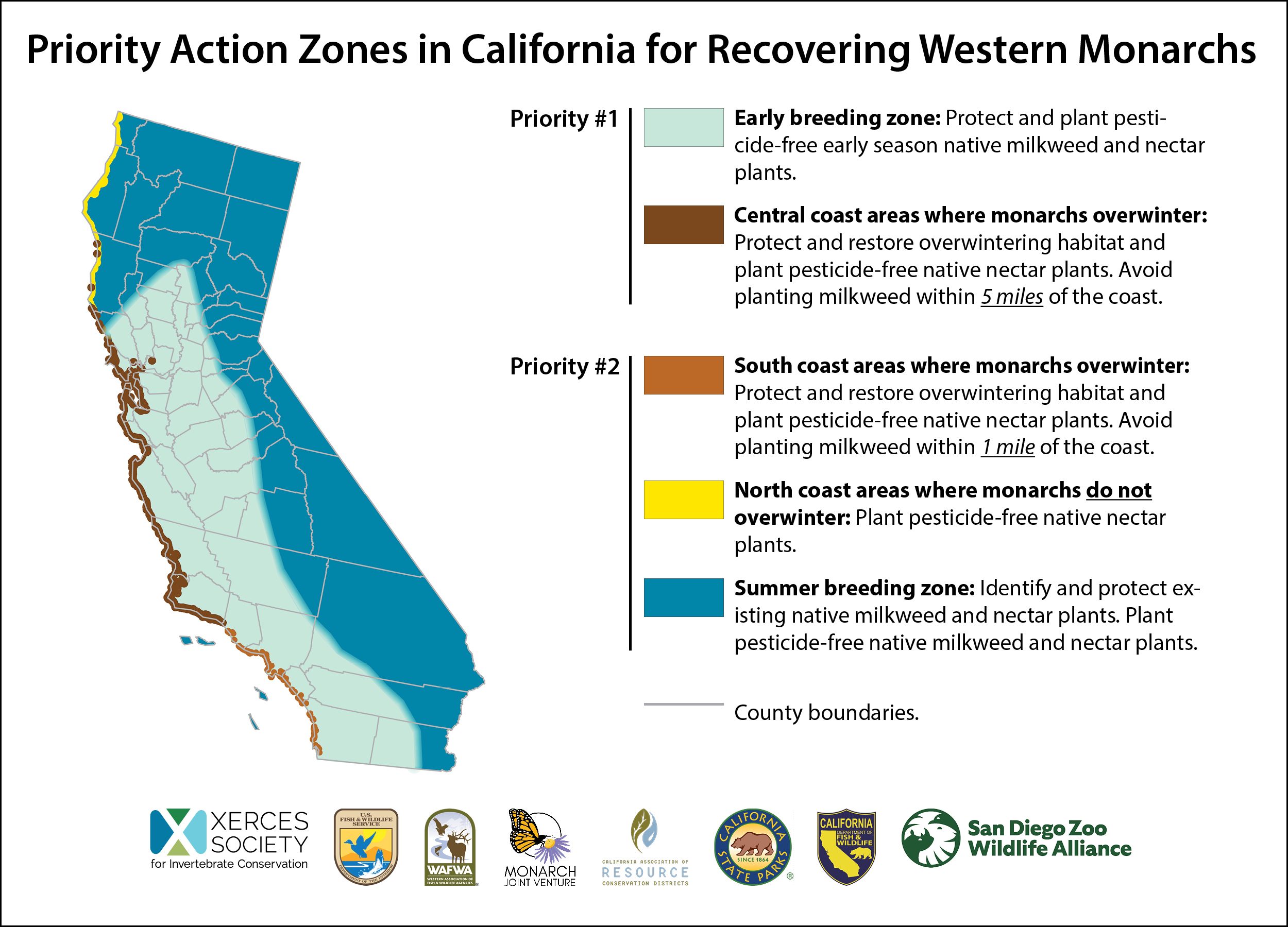Expert contacts:
Angela Laws, Endangered Species Conservation Biologist, Xerces Society for Invertebrate Conservation
(785) 236-1118 | [email protected]
Jessa Kay-Cruz, Senior Pollinator Conservation Specialist, Xerces Society for Invertebrate Conservation
(530) 510-0976 | [email protected]
SACRAMENTO, Calif.; Tuesday, August 10, 2021---From a nature reserve in Los Angeles to a school garden in the Central Valley to tribal land in the Sierra Foothills, over 140 habitat projects creating safe places for monarchs and other pollinators have been made possible through the Xerces Society’s habitat kit program in California. As a result, more than 72,000 native plants are already in the ground, with a further 34,000 plants planned for distribution and planting this fall.
The habitat kits program was launched in 2019 in response to the shocking declines documented by the Western Monarch Thanksgiving Count in the number of migratory monarchs overwintering in California. Getting habitat into the ground to support these butterflies became increasingly urgent.
“After the western monarch population crashed, we were brainstorming ways to rapidly increase our habitat restoration work,” said Angela Laws, Endangered Species Conservation Biologist with the Xerces Society. “We soon realized one of the most efficient ways to do this was to support people who are already interested in doing this important work.”
“Providing them with plants was the missing piece of the puzzle that enabled them to act quickly,” Laws added.
In the first two years, the Xerces Society distributed 72,217 native plants, including 29,206 milkweeds, to 55 partners. This year, Xerces has committed to providing 34,690 plants, including 14,650 milkweeds, to an additional 89 project partners. The plants are all native species and selected to be regionally appropriate, drought-resistant and preferred by monarchs and other native pollinators.
This year, in order to best support the recovery of this imperiled species, most of these native milkweeds and other wildflowers, shrubs and grasses will be planted in the monarch butterfly’s highest priority restoration zone, where the first generation of monarchs breed in the spring after leaving the coastal overwintering sites.
Project partners include community groups, conservation districts, public agencies, farmers, ranchers and other individuals and organizations. Thanks to their efforts, critically needed climate-resilient habitat is being created on working lands and in public spaces, in natural areas and urban pollinator gardens.
“The response to this program has been amazing,” said Jessa Kay Cruz, Senior Pollinator Conservation Specialist with the Xerces Society. “Our partners have created acres and acres of high-quality habitat for monarchs and other pollinators. We are happy we can support so many great projects.”
The California habitat kits have proved to be very successful and will be available again in 2022. Building on this success, Xerces has recently established similar programs in Santa Fe, N.M., and the Northeastern United States.
###
Details of Xerces Society’s Habitat Kits Program can be found at https://xerces.org/pollinator-conservation/habitat-kits
Information about the status of the western migratory population of monarchs can be found at https://xerces.org/blog/western-monarch-population-closer-to-extinction-as-wait-continues-for-monarchs-protection
ABOUT THE XERCES SOCIETY FOR INVERTEBRATE CONSERVATION
The Xerces Society for Invertebrate Conservation protects the natural world by conserving invertebrates and their habitat. Established in 1971, the Society is a trusted source for science-based information and advice and plays a leading role in protecting pollinators and many other invertebrates. Our team draws together experts from the fields of habitat restoration, entomology, plant ecology, education, community engagement, pesticides, farming and conservation biology with a single passion: Protecting the life that sustains us. To learn more, visit xerces.org or follow us @xercessociety on Twitter, Facebook or Instagram.
PHOTOS
The following images have been released for use. Please include a credit as shown above each image. To download, right click on the image and select save.
Description: Map of California showing the priority actions zones for recovering the migratory population of western monarchs.
Credit: Xerces Society

For more information about the zones, see the fact sheet at https://xerces.org/publications/fact-sheets/priority-action-zones-in-california-for-recovering-western-monarchs
Description: Using the plants from the habitat kit awarded by Xerces as well as its own resources, Mygrant Ranch is transforming an area of nearly 400 acres from land that was historically over grazed by cattle into a lush and diverse haven for pollinators and other wildlife.
Credit: Bill Milligan

Description: At San Joaquin Delta College, in Stockton, Calif., professor of horticulture James Husting and his students used the Xerces habitat kit to create this “Monarch Meadow.” The project not only provided hands-on learning about habitat restoration, but also serves as an educational and conservation advocacy tool in the community.
Credit: James Husting

Description: Organic farmer Sherri Wood used the plants provided by Xerces’ habitat kit to plant a 2,600-feet-long hedgerow. Wood collaborated with the Center for Land-Based Learning, Putah Creek Council, and Yolo County Natural Resources Conservation Service to install and care for the hedgerow.
Credit: Sherri Wood

